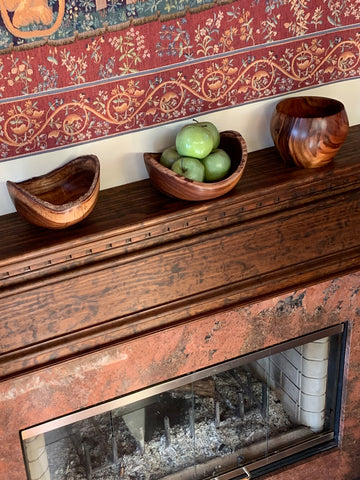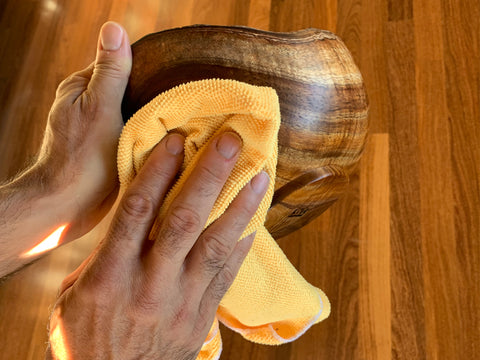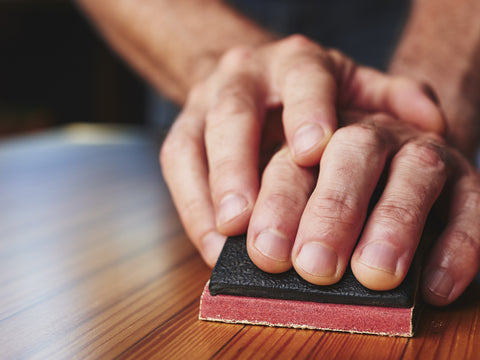How to Care for Koa Wood
Jun 27, 2020
I’ve been getting a lot of questions recently about how to care for Koa wood. Whether it is a customer asking about caring for a Koa bowl purchased from my site or someone who is dumbfounded about how to begin restoring his Koa wood coffee table's luster, caring for Koa wood is top of mind for those of us who want to protect our highly valued heirlooms.
Caring for Koa wood varies depending on the wood piece you're working with, and the environment it is in. Generally speaking, with the exception of some nuances, Koa wood maintenance is easy. It requires periodic dusting, oiling with furniture oil, and finishing with some form of polish or wood sealant.
If you want to protect your investment and ensure that your Koa furniture and/or art piece last for generations, caring for your Hawaiian art will be of the utmost importance.
Pay Close Attention to Environment
 Wood is an organic material and is subject to the environment and its fluctuating changes. Everything from sunlight and heat to humidity and moisture can and will have an effect on your wood. The first line of defense is to strategically place your piece away from sunlight and heat. This means avoiding areas near an uncovered window, vents, or fireplace. Heat can distort the wood color, erode the finish, and potentially deform the wood and cause cracks. The side picture is an example of what NOT to do. The wooden bowls sitting on the mantle are vulnerable to the heat produced by the fireplace.
Wood is an organic material and is subject to the environment and its fluctuating changes. Everything from sunlight and heat to humidity and moisture can and will have an effect on your wood. The first line of defense is to strategically place your piece away from sunlight and heat. This means avoiding areas near an uncovered window, vents, or fireplace. Heat can distort the wood color, erode the finish, and potentially deform the wood and cause cracks. The side picture is an example of what NOT to do. The wooden bowls sitting on the mantle are vulnerable to the heat produced by the fireplace.
Dust Frequently

The importance of dusting and its effect on the wood's appearance is often underestimated. Fine-grained particles in the air will build a thin layer on wood that can scratch the wood and hide its radiant surface. Frequent dusting keeps this buildup from happening. Using a microfiber (like the one pictured above) or cotton cloth will ensure you avoid damaging the wood. You can also use an electrostatic cloth or lambswool for hard to reach or detailed ornate areas. These charged materials attract dust particles using static electricity.
Dusting is simple and easy. Do it often. You'd be surprised at the luster that is lurking just below the filmy layer.
Use Caution with Wood Cleaners
Sometimes dusting isn't enough and the tendency is to reach for wood cleaners.  However NEVER use an "All-Purpose" cleaner, it will in all likelihood damage the wood finish. Instead, use a damp (not wet) cloth to remove any dirt or stains that dusting fails to clear away. Make sure to leave the wood dry. If you desire you can use a wood polisher but be careful not to use too much. These products use petroleum or distillates to create a shiny finish which can build up and mix with dust and dirt leaving behind a cloudy dull mess. Buffing with a paper towel can help you avoid any buildup.
However NEVER use an "All-Purpose" cleaner, it will in all likelihood damage the wood finish. Instead, use a damp (not wet) cloth to remove any dirt or stains that dusting fails to clear away. Make sure to leave the wood dry. If you desire you can use a wood polisher but be careful not to use too much. These products use petroleum or distillates to create a shiny finish which can build up and mix with dust and dirt leaving behind a cloudy dull mess. Buffing with a paper towel can help you avoid any buildup.
Caring Specifically For Your Koa Wood Bowl or Heirloom

The condition of your bowl's surface or coating will influence how you approach the care and maintenance of your Koa wood bowl. You'll want to inspect the surface first. If it shows signs of instability, loose portions, or damaged surfaces, it should probably be referred to a conservator or wood finishing professional. If the surface is stable, you can use the maintenance suggested guidelines.
Most Koa bowls sold at KoaWood Ranch have been simply finished with Danish Oil and beeswax. So caring for the bowl is simple and easy and if that's the case with the bowl you own, you'll want to:
- Dust periodically.
- Apply a coat of beeswax once a year (more often if you live in a dry climate.)
- If it is extremely dry, you can also re-oil it before applying an additional coat of beeswax
If you have a bowl that has been finished (with mineral oil) for food handling you may want to:
- Wash it by hand with mild soap and warm water. (Never use metal or sharp materials that may scratch the wood surface. Use instead nylon, scratch-resistant, or wooden utensils.)
- Dry immediately. Do not let any liquid sit in the bowl. Do not leave the bowl soaking in the sink.
- Apply a thin coat of mineral oil periodically.
If your bowl has been sealed with varnish you shouldn't have to do much more than dust it, and if desired, you can wax or polish it with a wood polisher. However, be warned that not all polishes are created equal. Some can do more harm than good.
Aerosol polishes are known to introduce silicone oils and other contaminants onto the wood. ln addition, they may contain solvents that attack varnishes and lacquers. So I would avoid using them.
Liquid polishers come in an array of forms, like oil and nondrying oil. I stay away from both because they contain complex bends of ingredients including perfumes and colorants that can create long term damage.
Drying oil, such as Danish Oil is best if employed as the finish, but not always great if it is used as a maintenance polish because it can discolor over time. I use it only if the wood is dry.
My favorite and least damaging to Koa wood is a wax. By comparison, waxes are stable and don't cause any of the problems inherent in the previously mentioned polishes. The only downside may be that they require a bit more effort to buff out. But the extra work is worth it.
Always good to remember:
- Never soak a wood bowl, or let it sit in a liquid.
- Never place a wood bowl in the microwave or conventional oven.
- Do Not place a wood bowl in the dishwasher.
- Do Not let a wood bowl sit in the sun.
Protecting Koa Wood Furniture
Nicks and cracks are inevitable but there are things you can do to help hide or prevent them completely. For example, abrasions can be hidden by using a liquid polish scratch cover. In some cases, buffing out the area will take care of the issue.
But the best approach is to minimize the elements that cause damage due to daily living by taking some precautions. For example, using coasters will help avoid making moisture contact with the wood and trivets can protect from direct heat and burns. Personally, I always use table cloths and mats. Not only do they protect from tabletop scratches, but they also absorb and protect against spills...I've been known to knock over a wine glass or two :)
Avoid Letting the Wood Dry Out
When wood dries out it causes unequal shrinkage and as a result, it can rot and you can get cracks. Wood can succumb to drying out from being stored away for a long time or due to the fact that you live in a dry environment. It's important to periodically inspect the wood's condition.
Finishing oils are engineered to allow for the deep penetration of wood pores in order to nourish and protect it. This gives it a long-lasting and water-resistant barrier. I find that Danish Oil effectively penetrates and best enhances the natural beauty and grain of Koa wood. I use Danish Oil on all of my Koa woodwork and only re-oil when the piece appears to be dried out.
If the wood has been varnished or resins have been applied, the wood surface and its pores are permanently blocked. These processes inherently restrict movement and essentially plasticize the wood. So it isn't necessary to apply oils; oils will not penetrate through. That said if the varnish or sealant is worn and porous, you may want to restore and/or refinish the wood to protect it and reinvigorate its look.
Restoring and Refinishing Koa Wood

Your approach to restoring and refinishing Koa wood will depend in part on your objective. Do you want a brand new look or are you okay with the piece looking old? A new look will involve much more labor and an old look may be easier.
If you're looking to restore a historic or antique piece of Koa wood furniture, and you're okay with it looking old, then you're only concerned with cleaning up the piece. This will involve first repairing any damage (e.g. refitting, replacing parts, or re-adhering joints). Then you'll want to clean it with a wood cleaner, like Murphy's Oil Soap, or something equivalent. Then prepare the surface with #0000 steel wool, always working with the grain. This will remove dirt and grime. Once complete, go ahead and apply your furniture oil and let it soak into the wood. Wait 24 hours before adding a protective coating of furniture wax.
If you're looking to completely refinish the Koa wood piece, you will have to strip off the existing finish completely down to the bare wood. This is very labor-intensive. After repairing any damage you'll then resand the entire piece in detail until it is uniformly smooth. This includes steaming out or filling in any dings. With the wood back to a complete and unfinished state, you can apply the oil. Add the protective wax or finish after it has set for at least 24 hours.
Never use stains on Koa wood. Beauty is inherent in the wood and you won't want to cover it up. Koa comes in different colors and stains will alter the natural look.
Longevity Is Your Reward
The reward for your effort to maintain and care for your Koa wood piece will be a home filled with beautiful heirlooms, conversation pieces, and furniture that looks and feels as it did the day you first got it — now and for generations to come.



